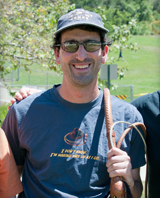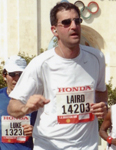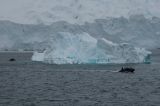
-CIA- World Factbook
-Cool Antarctica
-Discovering Antarctica
-FrankHurley.org

Laird's Bio

Follow Laird at
RunLairdRun.com

Support One of
Laird's Charities
Chapter 13 | Chapter 14 | Chapter 15

A friend asked me if Antarctica looked like the documentaries on the Discovery Channel. I enthusiastically said yes but that it was so much more. It was like Disneyland - every view contained something else to see and experience with sounds and smells and the feeling of the cold air on your exposed skin and the slippery ice beneath your boots. It was about the changing from moment to moment and yet powerful due to the immensity of huge monolithic ice sculptures bigger than our ship. In short, it was less like watching the Discovery Channel and more like being ON the Discover Channel. And yet, until we get holodecks, there is no way to really convey this feeling to people without them making the journey.
Reaching the base of a glacier, we then were allowed to climb up above the beach. This 30 degree hill wasn't too challenging as we kicked out steps in the loose snow/ice top layer. And oh what a view! More of the glacier reached above us. Icebergs and floes drifted in the harbor. Penguins and seals bobbed up and down in the water at the sea's edge. A cadre of penguins moved up and down the slope without much difficulty - and definitely less than we had. In the past two landings, the smell of the penguin guano had been intense, but it was so windy today that I don't think any smell could have stuck around. Ice crystals pelted our exposed faces.
Until United Continental schedules regular flights (which I hope will never happen), the next best option is to bring back a piece of Antarctica. As part of our journey to Antarctica, the tour operators required anyone going on shore (in short, everyone) to attend a briefing on the regulations regarding our behavior. Quark, who operated the ship, and Marathon Tours, who ran the race, both belong to the International Association of Antarctica Tour Operators (IAATO). This group coordinates activities for the vast majority of tours operating in the Southern Ocean and around Antarctica. For example, they publish statements such as these:
Protect Antarctic Wildlife
- Taking or harmful interference with Antarctic wildlife is prohibited except in accordance with a permit issued by a national authority.
- Do not use aircraft, vessels, small boats, or other means of transport in ways that disturb wildlife, either at sea or on land.
- Do not feed, touch, or handle birds or seals, or approach or photograph them in ways that cause them to alter their behavior. Special care is needed when animals are breeding or molting.
- Do not damage plants, for example by walking, driving, or landing on extensive moss beds or lichen-covered scree slopes.
- Do not use guns or explosives. Keep noise to the minimum to avoid frightening wildlife.
- Do not bring non-native plants or animals into the Antarctic such as live poultry, pet dogs and cats or house plants.
These restrictions match those of international law. In the United States, the EPA handles all regulations with regards to Antarctica. So, violating any of the rules on the trip could possibly lead to the tour reporting the perpetrator to their country's local authorities upon returning to port. All of us happily signed the consent form acknowledging the hot water that would immerse us should we fail to comply. No signature? No shore time.
These very real and important rules did not interfere with the one type of item we could bring back from this pristine land: Photographs. I estimate that of the 120 passengers, easily 100 of them sported cameras around their necks, in their packs or stuffed into pockets. The other 20 (like my wife) took turns with their partners gizmos. As long as we did not alter the path or activities of the wildlife while taking pictures, we snapped away without prejudice.
Back to the Top
Chapter 13 | Chapter 14 | Chapter 15



